How to Implement Pair Programming In Healthcare

Healthcare software development carries high stakes. Errors in code can compromise patient data, delay critical care, or affect compliance with regulatory standards. With so much on the line, it makes sense that teams are adopting more rigorous, collaborative development practices like pair programming.
Although it originated from extreme programming (XP), pair programming has become popular across agile teams for its collaborative advantages and contribution to knowledge sharing. In complex and regulated environments like healthcare, this method is becoming increasingly valuable.
In the following sections, we’ll break down the tangible benefits of pair programming for healthcare teams, where it works best, how to implement it effectively, and what to watch out for.
Why Pair Programming in Healthcare Makes Sense
Healthcare organizations operate in highly regulated environments with long development cycles and limited tolerance for errors. Pair programming introduces real-time review and collaboration into the development process, which can lead to:
- Fewer bugs in production due to continuous peer review. (Example: Healthcare teams using pair programming to improve QA)
- Improved compliance by having two minds align on data handling and privacy requirements.
- Knowledge sharing that helps onboard new developers faster, especially in teams working on electronic health records (EHR), patient portals, or telemedicine platforms.
4 Benefits of Pair Programming in Healthcare Teams
From reducing coding errors to speeding up onboarding, pair programming offers multiple advantages for healthcare teams working on high-impact, compliance-sensitive software.
1. Reduces Risk in High-Stakes Codebases
Whether it’s insurance portability and accountability act (HIPAA) compliance or integrations with medical devices, healthcare developers are under pressure to get it right. Pair programming helps reduce individual blind spots and uncovers issues earlier in the development cycle, leading to higher code accuracy and fewer post-deployment issues.
Use the HIPAA compliance checklist template to map and track every security requirement across development phases.
Real-World Example: Pair Programming in Action at a Healthcare Non-Profit
When a large non-profit healthcare organization teamed up with World Wide Technology (WWT), it faced a common challenge: legacy systems and slow waterfall releases. To change that, they adopted agile practices, including pair programming.
By pairing engineers and product leads in every sprint, the team created a high-collaboration culture where feedback loops were fast and decisions were shared. Within just 60 days, they went from weekly deployments to delivering high-quality software in minutes. Pair programming played a crucial role in building trust among technical and clinical stakeholders while reducing delivery risk in a high-stakes environment.
2. Enhances Code Readability and Maintainability
When two people write code together, they naturally explain their thought process aloud. This habit creates cleaner, more logical code that’s easier for others to read and maintain, especially useful in healthcare projects that are often revisited for updates, certifications, or audits.
Combine this with the healthcare quality assurance template to structure pre-deployment review and documentation across teams.
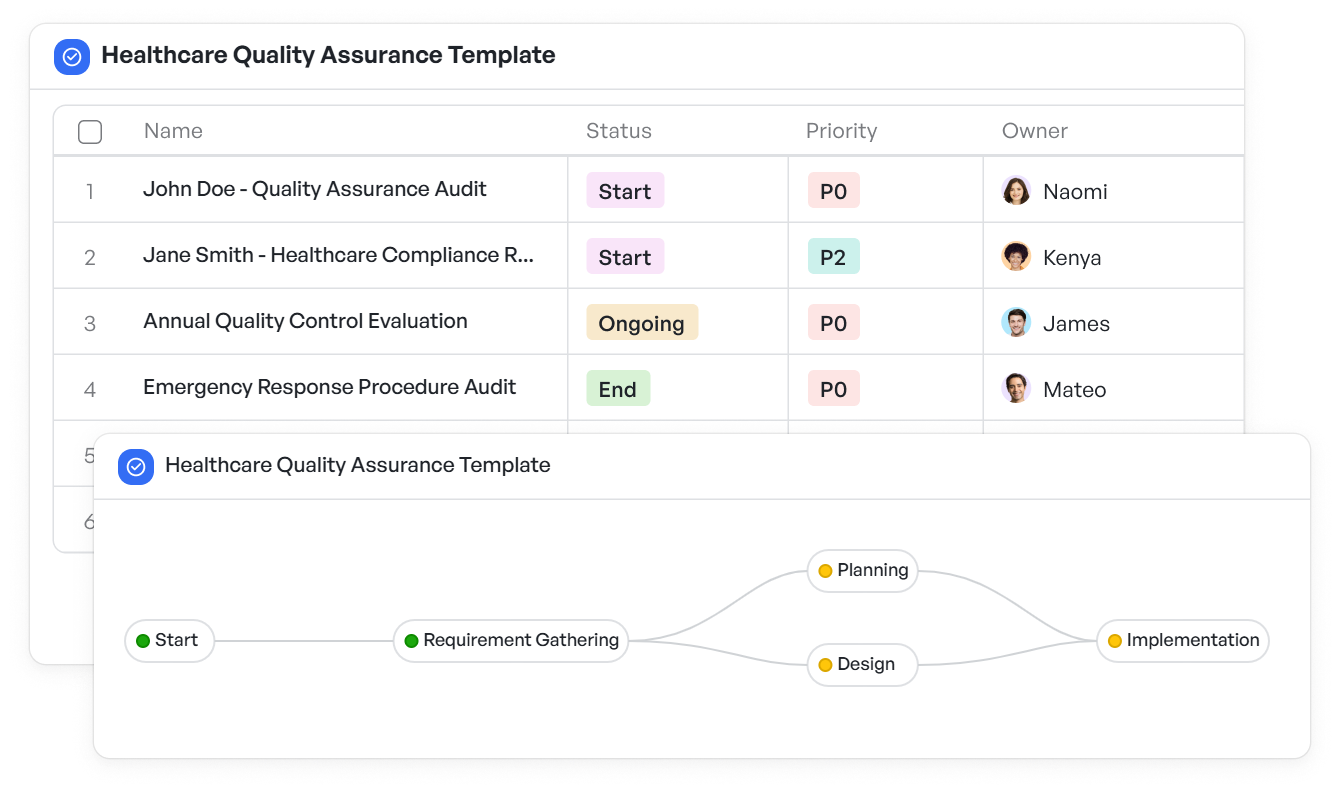 Built-in quality checks with structured templates for compliant, maintainable code
Built-in quality checks with structured templates for compliant, maintainable code3. Accelerates Learning and Onboarding
Healthcare IT systems can be notoriously complex. New engineers face a steep learning curve. Pair programming shortens onboarding time by giving junior developers direct access to senior team members' decision-making process, helping them understand domain-specific standards, integrations, and workflows.
The healthcare training program template is a great companion to codify onboarding checkpoints, shadowing opportunities, and pairing schedules.
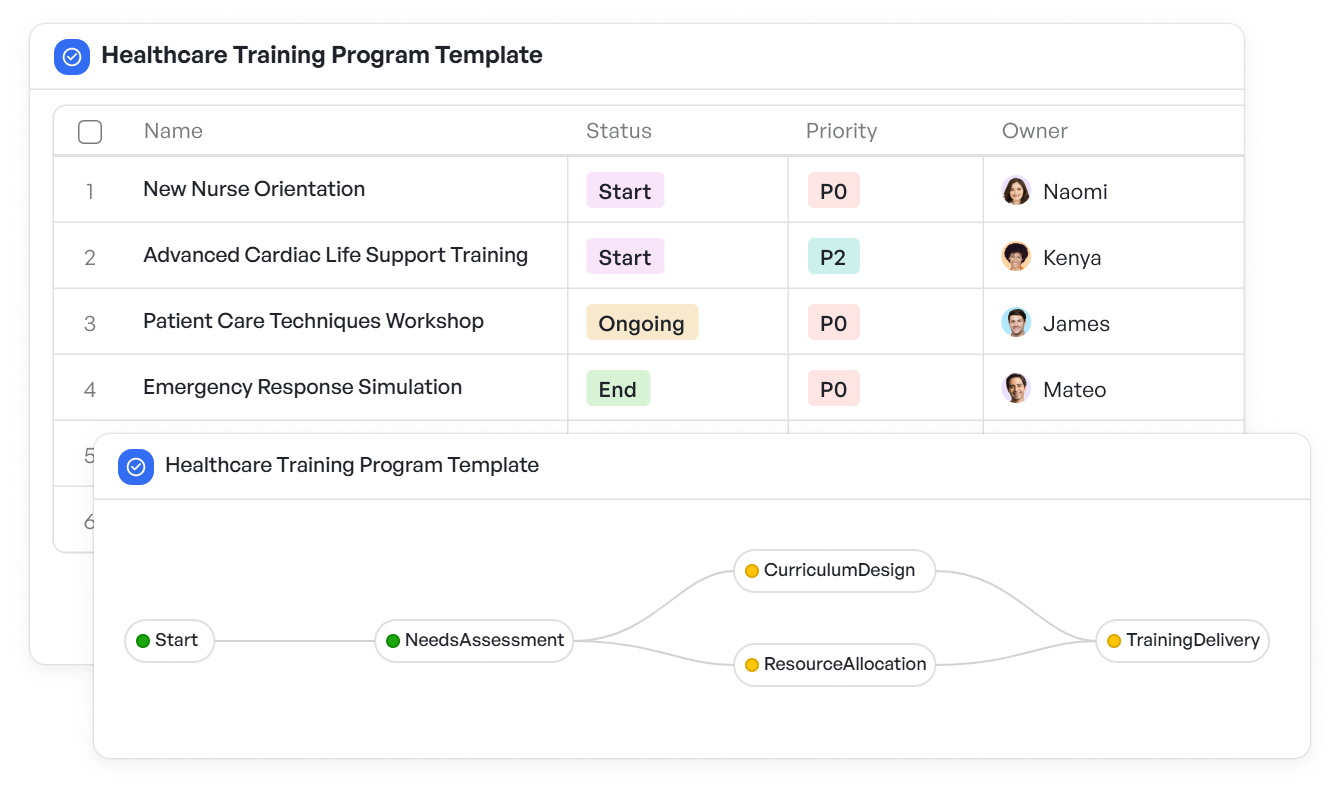 Codified onboarding pathways with guided pairing and domain-specific checkpoints
Codified onboarding pathways with guided pairing and domain-specific checkpoints4. Improves Team Communication
Working side by side fosters deeper communication among developers. It builds a shared understanding of project goals, which is critical in cross-functional healthcare teams that often include developers, compliance officers, clinicians, and administrators.
Use the healthcare strategic planning template to align cross-team priorities and schedule collaborative sprints or pairing rotations.
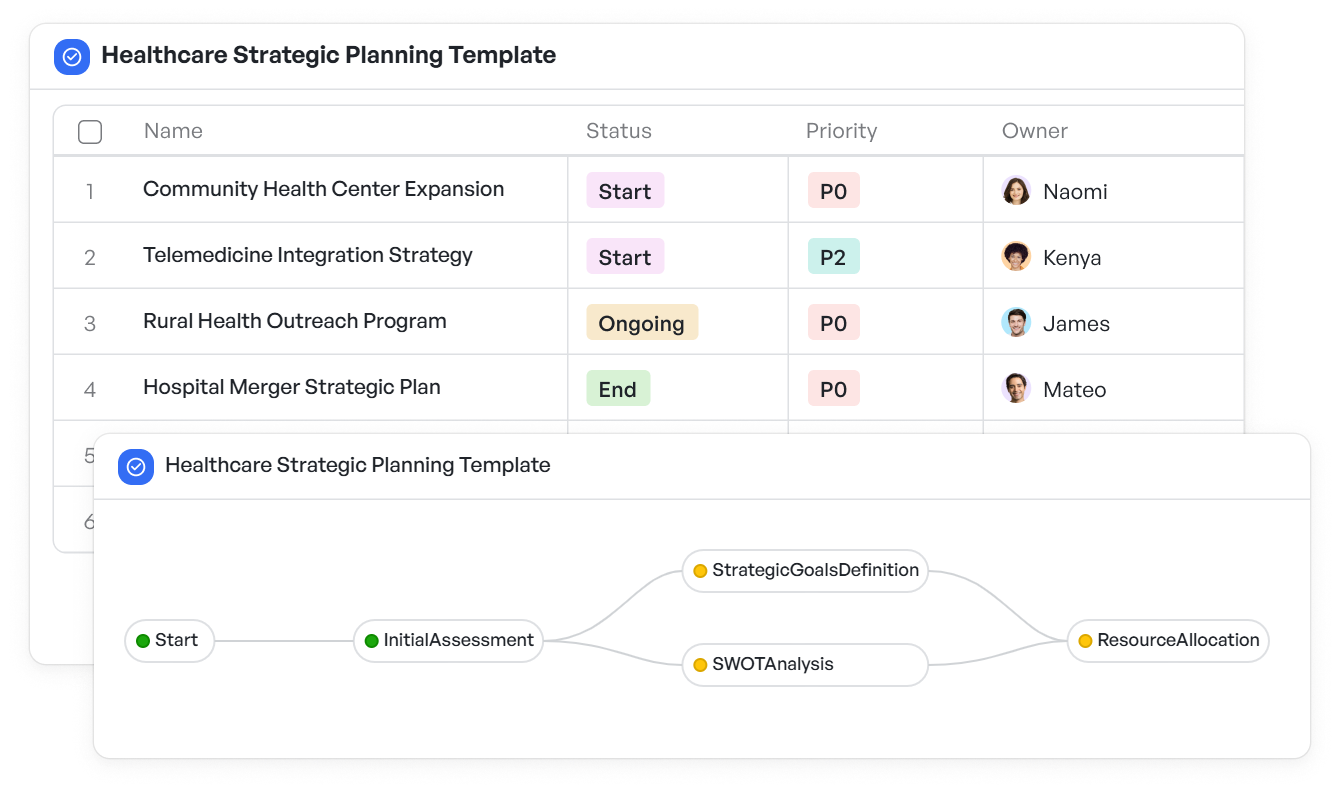 Aligned cross-functional goals through structured pairing and strategic sprint planning
Aligned cross-functional goals through structured pairing and strategic sprint planningYou might be interested in: 👉Extreme programming for collaborative culture
Use Cases of Pair Programming in Healthcare
Pair programming isn’t a blanket solution, but it does fit well in several healthcare software scenarios:
- Electronic Health Records (EHR): Building modules that require strict validation rules, secure login systems, and audit trails.
- Clinical Decision Support Tools: Ensuring logic and accuracy in algorithms used for diagnosing or flagging patient risks.
- Insurance Claim Platforms: Reducing financial and regulatory risks in claim processing logic.
- Telemedicine Portals: Enhancing real-time features like video, chat, and integration with digital vitals.
At Children’s Hospital Los Angeles (CHLA), the internal software development team adopted pair programming and mob programming practices to improve the quality and efficiency of their healthcare IT systems. With support from agile consultancy Industrial Logic, CHLA’s developers began working in closely coordinated pairs to build tools that supported hospital operations and patient care.
The primary goal was to minimize errors and improve collaboration in a high-stakes environment where software bugs could impact clinical workflows. By pairing two engineers at a single workstation—typically a “driver” who writes code and a “navigator” who reviews and guides—the team ensured constant code review, immediate feedback, and better decision-making.
Over time, this approach:
- Reduced defects and rework, thanks to early detection of logic or design issues.
- Improved team learning, especially when pairing junior and senior developers.
- Created a culture of shared ownership, with developers feeling more accountable for the final product.
This shift was particularly effective in the healthcare setting, where software must meet strict compliance and safety standards. CHLA reported smoother releases, stronger team morale, and better alignment with clinical stakeholders as a direct result of pair programming.
If you are interested in this article, read about it on: A fruitful approach to pair programming
When Not to Use Pair Programming in Healthcare
Not every task benefits from pair programming. It’s best reserved for:
- Critical features that impact patient care or compliance.
- New or unfamiliar codebases.
- Complex architectural decisions.
- Situations where mentorship is part of the goal.
Tasks like documentation, repetitive updates, or straightforward UI changes may not require pairing and can be handled independently.
4 Steps to Get Started with Pair Programming in Healthcare Projects
Establishing a strong foundation for pair programming in healthcare begins with a few focused actions that ensure clarity, collaboration, and compliance from the start.
1. Define Roles Clearly
Assign the driver and observer roles explicitly. Switch roles periodically to avoid fatigue and keep both developers engaged. Some teams alternate every 30 minutes or after each task is completed.
Use the medical staff allocation template to structure shifts, availability, and who gets paired for which sprint.
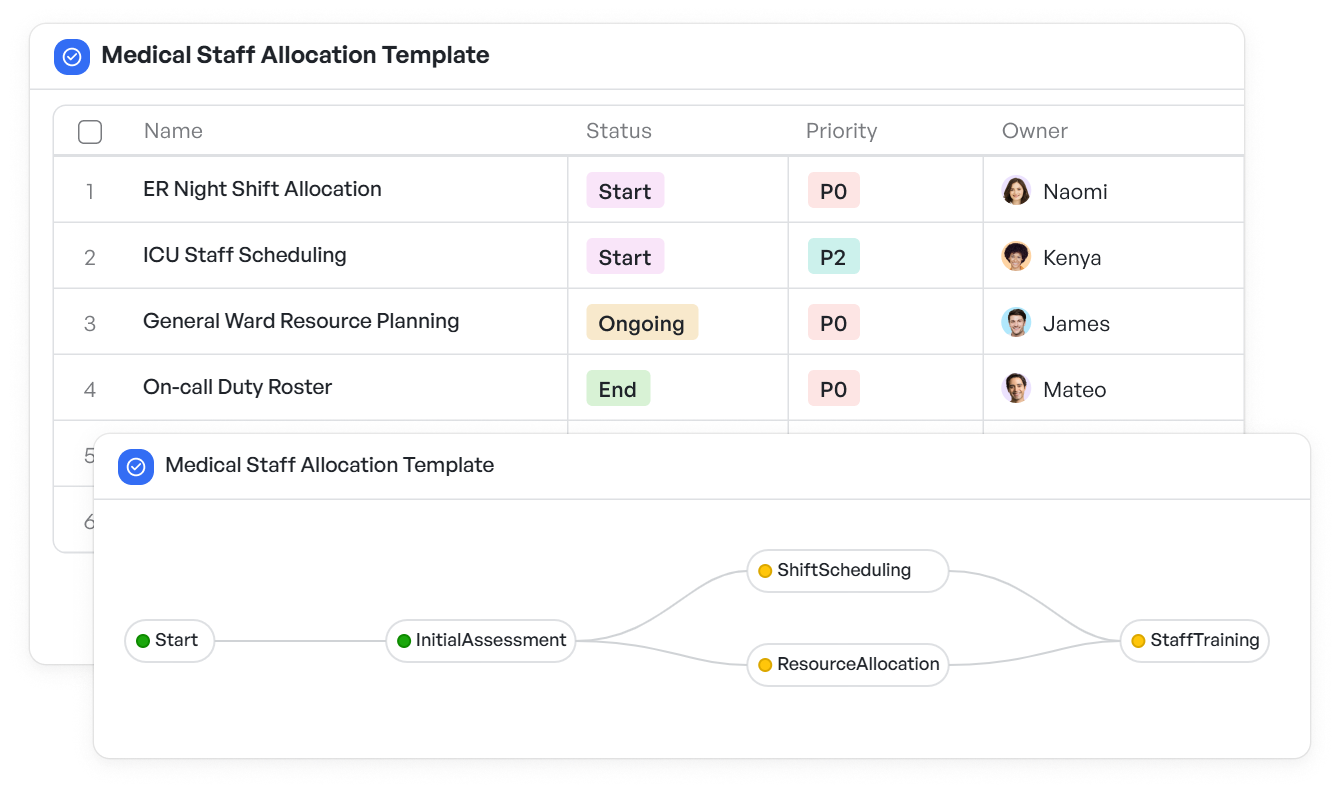 Structured role assignment and pairing rotation with clear sprint-level visibility
Structured role assignment and pairing rotation with clear sprint-level visibility2. Choose the Right Environment
Whether you're co-located or remote, the development environment should support smooth collaboration. Tools like shared IDEs, live coding platforms, or remote pair programming extensions can help.
Meegle’s healthcare project scheduling template helps visualize and assign daily pair sessions alongside deadlines.
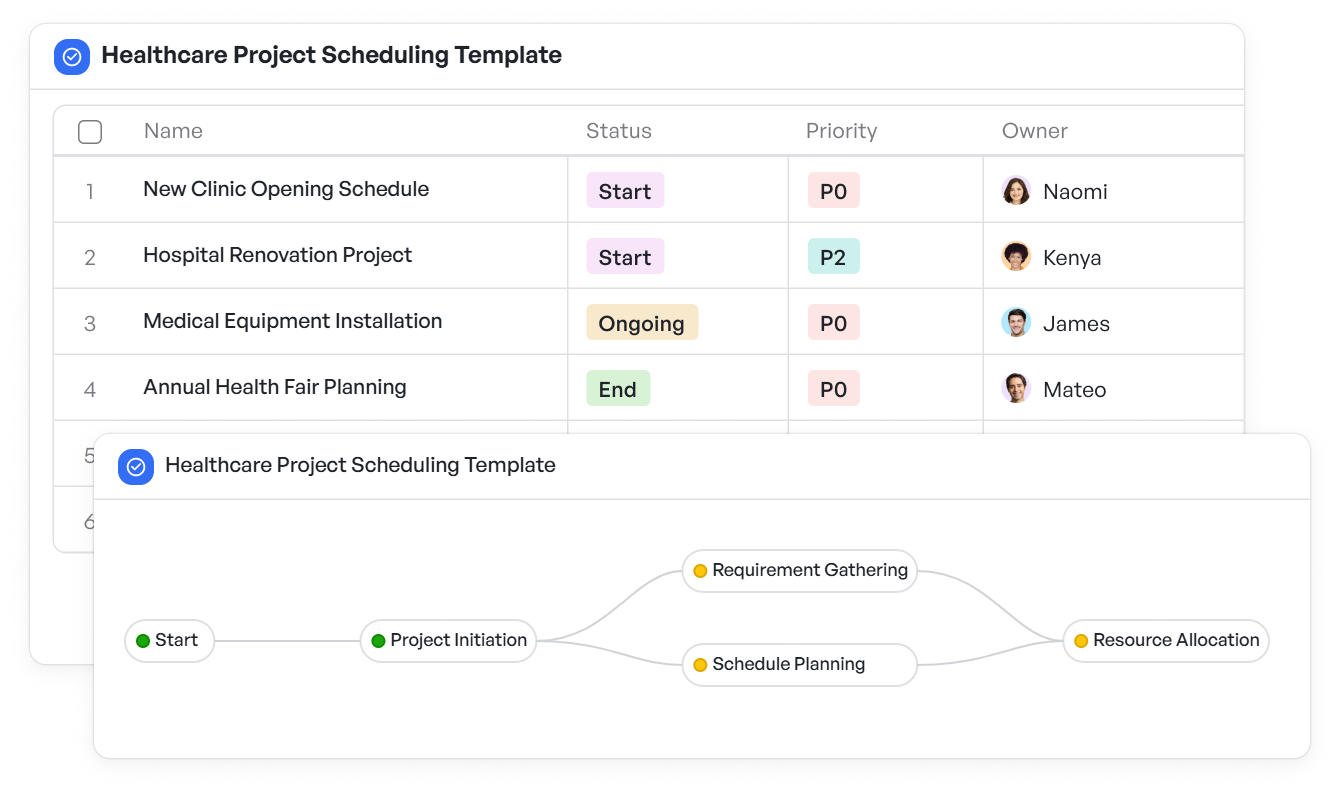 Optimized pairing sessions with visual scheduling for seamless daily collaboration
Optimized pairing sessions with visual scheduling for seamless daily collaboration3. Align on Standards
Establish shared coding standards and healthcare compliance practices (like HL7, HIPAA, or FHIR) beforehand. This ensures both partners are aligned on data privacy and format expectations.
Using the healthcare policy update template allows for seamless integration of changing compliance directives into your development SOP.
4. Measure Results Over Time
Track metrics like bug reduction, onboarding time, or review cycles. In many healthcare teams, the qualitative benefits (less rework, improved collaboration) often outweigh hard metrics.
Integrating Pair Programming in Healthcare into Agile Development Teams
Many healthcare software teams follow agile or hybrid methodologies. Pair programming fits well into daily standups, sprints, and backlog grooming. It can be introduced gradually, starting with one team or a specific epic.
Meegle's visual workflows supports this kind of collaborative, iterative approach. It helps team members see how development tasks connect to broader processes like compliance documentation, release approvals, or stakeholder reviews.
If you're aiming for clear responsibility mapping and cross-team accountability in healthtech workflows, the patient data management template can help structure your development and deployment cycles more effectively.
 Streamlined agile collaboration with mapped responsibilities and integrated compliance workflows
Streamlined agile collaboration with mapped responsibilities and integrated compliance workflowsSmarter Collaboration Leads to Safer Outcomes
Pair programming isn’t just about writing better code; it’s about building a more reliable, communicative, and agile development culture—especially in an industry where lives can depend on software.
Healthcare organizations that integrate collaborative techniques into their dev cycle often gain a clearer picture of their code quality, team readiness, and compliance adherence.
Experience how Meegle can support pair programming in healthcare environments where precision and speed are critical.
The world’s #1 visualized project management tool
Powered by the next gen visual workflow engineRead More
Check All BlogsStart creating impactful work today



